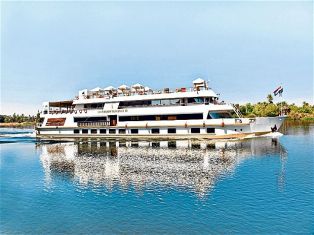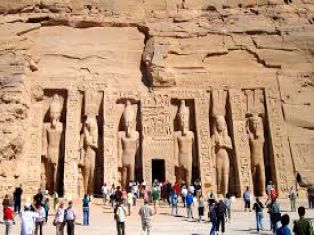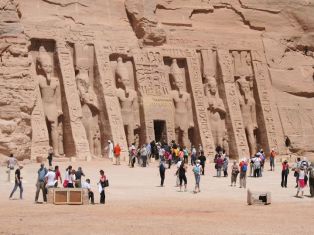Luxor Temple
**General info:- **
One of the most famous temples built in the Middle Ages; King Amenhotep III built the temple on the east bank of the Nile River, the purpose of his construction is to worship the king of gods (Amoun Raa). It is an ancient Pharaonic tradition that the ruler in Egypt should be one of two choices: 1: the son of a former king. 2: To be a husband of a former king's daughter: That less believed. Amenhotep III was not one of these, but advised by friends to create a huge temple to prove his relationship with Amoun Raa, indeed; Amenhotep III ruled Egypt.
The Rams avenue:-
When you visit Luxor temple you will find a road up to the Karnak temple called (rams avenue); the rams symbolizes to Amoun. the purpose of its construction is the sacred boats walking through it during the royal festivals and feasts.
The pylon:
In front of the pylon found the obelisk due to Ramses II, Inscribed on the obelisk the royal names of Ramses II, Titles and military achievements. The pylon is divided into two parts: The right part of the pylon the king sitting with his consultants explains the preparation of the war, the left part is shows king Ramses II war against Kiddush, while the king leads a war chariot. The façade of the temple is decorated with 6 statues of king Ramses II, two statues with seating position made of black granite stone and king Ramses II is crowned by the white crown, which refers to the Upper Egypt, other 4 statues with standing position made of red granite stone and king Ramses II is crowned with a double crown, which refers to the north and south union. unfortunately; only six statues remind due to time, erosion and earthquakes.
First Courtyard:
Founded by Ramses II, It is 51 meters long and 57 meters wide. The courtyard consists of 74 columns in the form of a closed papyrus plant, on the right there are 3 chambers dedicated to the worship of the Trinity (Amoun, Mout and Khonso), Created by Hatshepsut and Thutmose III To burn incenses and offer sacrifices to the sacred statues of gods. on the sides at courtyard there are statues of king ramses II with diffirent shapes show the extent of the ancient Egyptian skill and accuracy of sculptures and how to show the details of the body without any mistakes despite the hardness of the stone. In the front on the western side a wall displays the temple materialized; the sons of king Ramses II are led by Mernptah, who number about one hundred and eleven males, five daughters enter the temple with sacrifices and offering.
Hall of Fourteen pillars:
Preface this hall the pylon, it was an entrance during Amenhotep III, the hall has a fourteenth columns each seven on the row.in the form of an open papyrus. Recorded on walls of this hall Obit festival celebration, it’s an annual celebration of the convoy of the holy trinity to visit Luxor temple, the convoy includes three boats; the main boat is adorned with a heads of rams; symbolizing the god Amoun, the second boat of the god Mout is adorned by heads of women upon her head an eagle and the boat of Khonso is adorned with falcon, accompanied by musicians, soldiers, dancer and carrying the flag.
**Second courtyard: **
Located behind the courtyard of the festival, it has 64 columns in the form of papyrus. At the beginning of 1989, 26 statues representing kings and gods were found during the excavation to find out; the reasons for the displacement of some columns, which are now exhibited in the museum of Luxor. In the middle of the southern wall is a stairway that leads to a hall that in the roman era turned into a refuge for the hiding of the roman conquerors and their torture, where they painted some Christians forms on a layer of gypsum. An entrance leads to a room dedicated to the offerings, as it has engraved on its walls more than forty scenes of Amenhotep III, offering sacrifice and offerings to the god of Amoun. In the middle of southern wall we find an entrance leading to some of chambers that reach the holy boat chamber on its sides there are some rooms that were used as a stores for the things used in the daily service of the temple (oils, essences, incenses, clothing and utensils); the ceiling of this room had four columns removed by alexander the great to build his own compartment for the sacred boat of the god Amoun and engraving on the walls of the compartment from inside and outside his relationship with God Amoun, other scenes offering the donations. Reflections travel team advises the guests to visit the Luxor temple at night by moonlight and searchlight.
recommended tours

Private Half - Day Tour: Philae Temple - Unfinished Obelisk & High Dam



